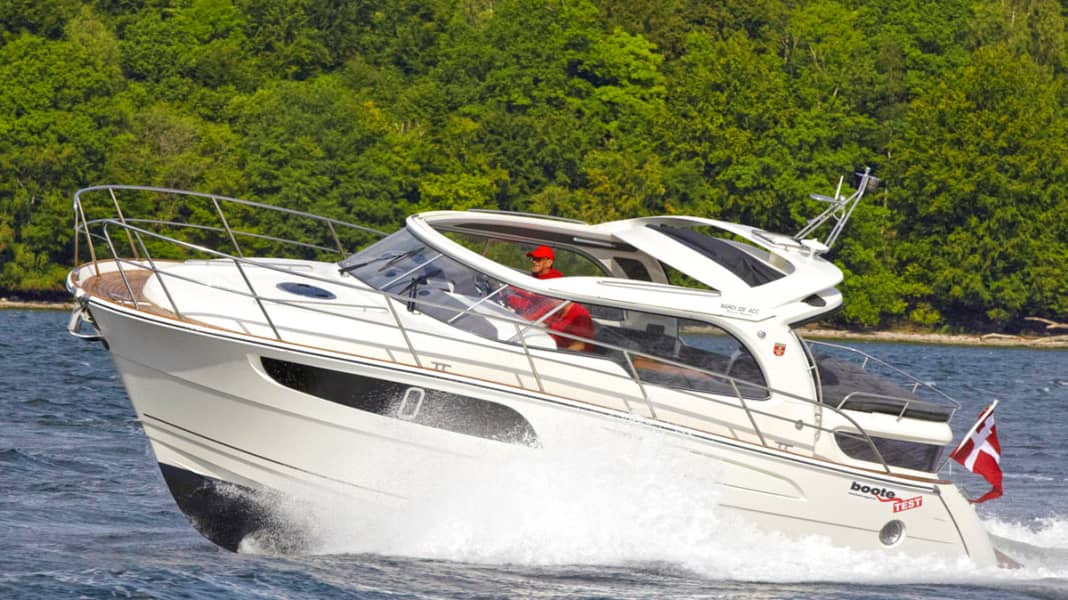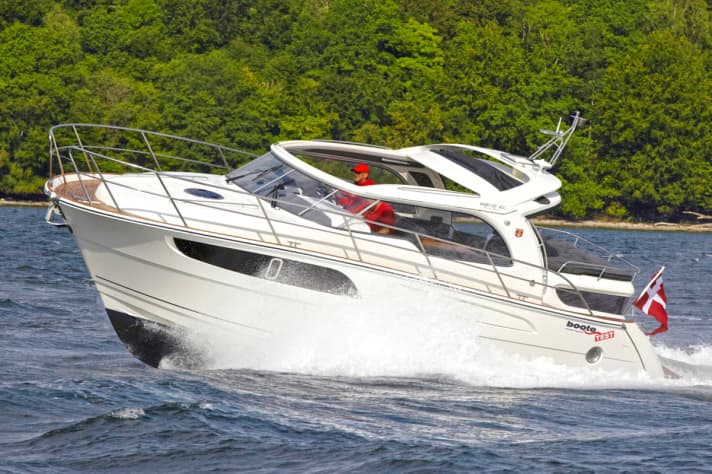Test: Marex 320 ACC








As soon as you look at the Marex 320 ACC, you realise that it has a very special aft cabin. This is because it sits enthroned next to the cockpit entrance above the rear area, not obtrusively, but in a well-dosed manner. The highlight of the roof is the sun lounger and storage space for the convertible top.
In the spacious cabin there are two separate bunks, which are perfectly ventilated and offer space for up to three people. However, you can not only lie on the cushions, but also sit and then write at a folding table, work on the computer, play cards or even have breakfast. The standing height of 1.90 metres in the front entrance area and the panoramic windows on the rear and side walls, which provide a great view outside, are also very pleasant. Last but not least, you also need plenty of storage space when travelling - there are plenty of cupboards, shelves and boxes (under cushions).
The same applies to the bow cabin, which is equipped with a huge, comfortable sunbathing area. The view through the large side windows to the outside is also particularly impressive here - and is best enjoyed while lying down. In front of the forward cabin, the designer has arranged the wet room with electric toilet and shower cubicle, which offers enough space for a person of normal height and width. Here, too, we are impressed by the headroom and the stowage options, which allow five people to store their bathroom utensils neatly.
The social life of the five takes place in the "galley" in the cockpit. A well-placed and well-equipped galley and a seating area offer the right level of comfort to spend pleasant days and evenings here. The highlight: depending on the weather and mood, the cockpit with sliding roof and convertible top can be
into a closed, sheltered space or a place in the sun, depending on the weather and mood.
in the sun.
Sun-seekers should use the aforementioned rear lounger or the foredeck with additional cushions (extra). Perfect: both lounger units have handrails as boundaries and therefore also good holding options. Bathing is from a platform with a 3-step ladder, which is located under a flap and is therefore difficult to operate from the water. The platform is adjoined by a forward locker in which plenty of fenders and lines can be stowed. A bulge in the stern shows the preparation for a stern anchor, which is available for an extra charge. A self-draining locker, bow fitting and electric winch (extra) are available on the foredeck for the bow anchor with chain and line.
Driving and manoeuvring
As is usual for a Scandinavian family cruiser, our test Marex is powered by an economical diesel engine. It brings her from displacement to gliding speed in a "quiet way". This phase begins at around 1500 rpm and ends just below 3000 rpm. However, this can only be recognised by the typical gliding stern wave, as the bow does not lower itself again until around 3400 rpm. In order to have a good view ahead during the entire phase and gliding, it is recommended to use the standard trim tabs, which can also be used to compensate for leaning due to one-sided loading or crosswinds. At full throttle, the flaps can be raised a little, as the Marex then becomes about 1.5 kn faster and the foresight remains unrestricted. Our test boat cruises economically at around 3250 rpm at a good 20 knots. The distance between start and finish is then 180 nm, which is a good distance for a cruising boat in this class.
In fast gyros, the hull turns smoothly and brakes automatically. However, the propeller always remains positive and the Marex immediately accelerates back to top speed when steering straight ahead. Cultivated handling characteristics are also evident on slalom courses and when turning the steering. The only drawback during fast manoeuvres: sharp steering makes the rudder stiff.
This is not noticeable at slow speeds and harbour manoeuvres are possible without any problems. The bow and stern thrusters (extra) also come to the rescue, allowing the boat to be manoeuvred perfectly.
During our test trip, we had winds of around 4 Bft. A short, steep choppy wave then builds up on the Baltic Sea, which the Marex hull passes through smoothly and with a stable course. When sailing against or at a slight angle to the wave, the wind carries spray up to the windscreen. A situation that can be promptly rectified with two double-arm wipers. In this context, we also like the washer nozzles on the windscreen wipers and the defroster nozzles in front of the windscreen, which guarantee the driver a clear view ahead in wet weather. Minus: The defroster system costs extra.
The rider sits on a bucket seat with firm cushions and raised side sections that provide secure support. The forward and backward adjustment allows most riders to find a relaxed seating position. Standing up is also possible, but then you first have to fold up the front seat cushion, which was stiff on our test boat. In contrast, the electronic single-lever control from Yanmar is absolutely smooth-running. The skipper can easily reach all the controls at the helm and reads the plotter perfectly, the other instruments are rather passable. The compass is located in the centre above the companionway, which makes it difficult to read, but has the positive effect that it is not distracted by other instruments. Next to the compass on the port side is a double bench, which can either be used as a passenger bench or folded down as an extension for the seating area.
Engine, tank, electrics
The engine is located under the floor of the cockpit living unit and can be accessed via a hatch. This is not particularly large - this access is sufficient for small service items, but for larger jobs it is best to remove other floor parts, which are not as easy to get out as the main hatch. The installations and the entire technical system make a tidy, professional impression. This includes, above all, the firmly pressed fuel hose connections, the additional diesel filter, stopcock and an aluminium tank bolted with lugs.
Four main switches are conveniently located in the footwell of the seating area to switch the safely positioned batteries. It almost goes without saying that the fuses are also easy to reach. Plus minus: the self-extinguishing sound insulation does its job well, the maximum engine compartment temperature is only just below 40 °C, which is only an adequate result at an air and water temperature of around 19 °.
Safety and equipment
Complete fire extinguishing equipment and two manual bilge pumps as well as an electric bilge pump and a large escape hatch are signs that Marex attaches great importance to safety. If you want to go to the foredeck, you can walk across wide, non-slip side decks. Solid handrails and railings provide support.
To moor the boat securely, there are sturdy cleats to match the other metal parts. The boat builders have fitted these just as well as the railing etc. During our test drive, some of the sun pads folded up on their own and we had the feeling that at least one of them had "run away". Nevertheless, apart from a few details, the workmanship leaves nothing to be desired.
Conclusion
With the 320 ACC, Marex has succeeded in creating a well-balanced boat with good handling characteristics and a neat finish. The family can enjoy travelling with the Norwegian just as much as two couples of friends.
Technical data Marex 320 ACC
- Shipyard: Marex
- Type designation: Marex 320 ACC
- CE category: B - Outside coastal waters
- Material of hull and deck: Plastic
- Length: 9,99 m
- Width: 3,30 m
- Displacement: 5,00 t
- Price: 237.507,00 €

